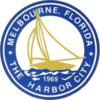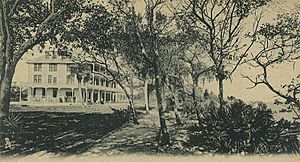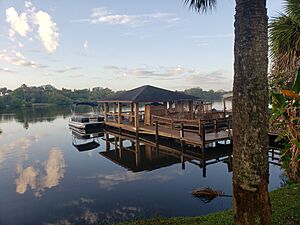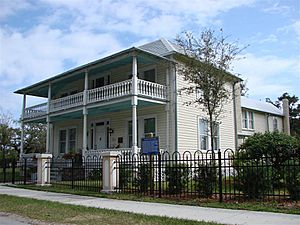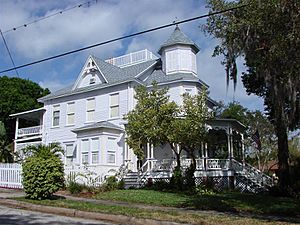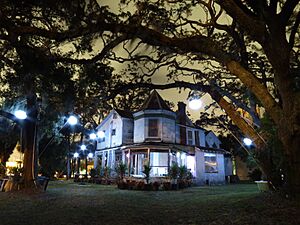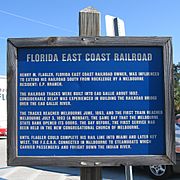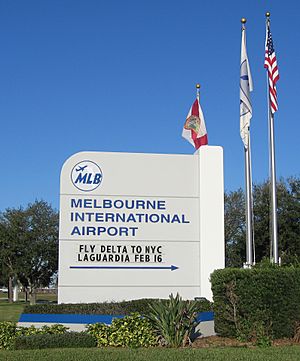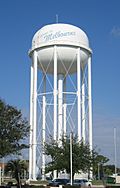Melbourne, Florida facts for kids
Quick facts for kids
Melbourne, Florida
|
|||
|---|---|---|---|
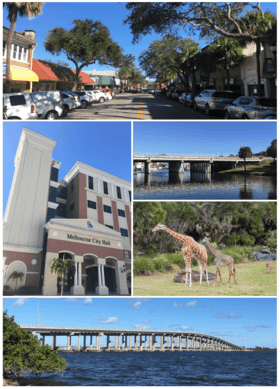
Top, left to right: Downtown Melbourne, Melbourne City Hall, Crane Creek, Brevard Zoo, Melbourne Causeway
|
|||
|
|||
| Nickname(s):
The Harbor City, The Midway City
|
|||
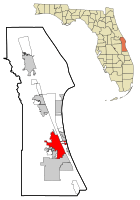
Location in Brevard County, Florida
|
|||
| Country | United States | ||
| State | Florida | ||
| County | Brevard | ||
| Settled | c. 1867 | ||
| Incorporated (village) | December 22, 1888 | ||
| Consolidated with Eau Gallie | July 15, 1969 | ||
| Founded by | Cornthwaite John Hector | ||
| Named for | Melbourne, Australia | ||
| Government | |||
| • Type | Council–manager | ||
| Area | |||
| • Total | 49.97 sq mi (129.43 km2) | ||
| • Land | 44.15 sq mi (114.36 km2) | ||
| • Water | 5.82 sq mi (15.07 km2) 14.4% | ||
| Elevation | 20 ft (6 m) | ||
| Population
(2020)
|
|||
| • Total | 84,678 | ||
| • Density | 1,917.83/sq mi (740.47/km2) | ||
| Time zone | UTC−5 (EST) | ||
| • Summer (DST) | UTC−4 (EDT) | ||
| ZIP code |
32901, 32934, 32935, 32940, 32902, 32912, 32936, 32941, 32904
|
||
| Area code | 321 | ||
| FIPS code | 12-43975 | ||
| GNIS feature ID | 0294589 | ||
Melbourne is a city in Brevard County, Florida, United States. It is about 72 miles (116 km) southeast of Orlando. Melbourne is also 175 miles (282 km) northwest of Miami. In 2020, 84,678 people lived there. This was more than the 76,068 people in 2010. Melbourne is the second-largest city in Brevard County. In 1969, Melbourne joined with the nearby city of Eau Gallie. The city is also home to the National Weather Service office. This office helps forecast weather for East Central Florida.
Contents
- History of Melbourne
- Geography and Climate
- People of Melbourne
- Melbourne's Economy
- Arts and Culture
- Sports and Recreation
- Parks and Attractions
- Public Libraries
- Education in Melbourne
- Media and News
- City Services and Transportation
- City Namesakes
- Notable People from Melbourne
- Images for kids
- See also
History of Melbourne
Ancient Times: Early People in Melbourne
Scientists found proof that very old groups of people lived in the Melbourne area. This was during the late Pleistocene epoch, also known as the Ice Age. This happened in the 1920s. A zoologist named C. P. Singleton found mammoth bones near Crane Creek. A paleontologist, Frederick B. Loomis, dug up more bones. He found a second elephant skeleton with a flint tool.
In the same layer of earth, Loomis found bones from many extinct animals. These included mammoths, mastodons, horses, and saber-tooth cats. These animals disappeared from Florida about 10,000 to 8,000 BCE. At another site, a human rib and charcoal were found near ground sloth teeth. In 1925, more discoveries were made at the Melbourne golf course. A human skull and bones were found with a horse tooth. Other finds included a spear point near a mastodon bone. Similar ancient human remains and tools were found in Vero Beach. This is about 30 miles (48 km) south of Melbourne.
How Melbourne Was Settled
The first people to settle here arrived after 1877. Among them were Richard W. Goode and his father John Goode. Also, Cornthwaite John Hector, Captain Peter Wright, Balaam Allen, Wright Brothers, and Thomas Mason. Three of these men, Wright, Allen, and Brothers, were black freedmen. Freedmen were formerly enslaved people who were now free.
The city was first called "Crane Creek." It was renamed Melbourne to honor its first postmaster, Cornthwaite John Hector. He was from England and had lived in Melbourne, Australia. He is buried in the Melbourne Cemetery. The first school in Melbourne was built in 1883. You can still see it at Florida Institute of Technology. By 1885, about 70 people lived in the town. The Greater Allen Chapel African Methodist Episcopal Church started in 1885 and is still active.
In the early 1900s, many houses were built in a simple, local style. In 1919, a big fire destroyed most of the old downtown area. It was then rebuilt west of US Highway 1.
During the Jim Crow era, there were unfair rules for black people. For example, they had to use different entrances at movie theaters. They also had to sit in separate areas. Gas stations had separate restrooms for "Colored" people. These rules lasted until the late 1960s when integration began.
In 1942, the Naval Air Station Melbourne was built. It trained Navy and Marine pilots for World War II. This program ended in 1946. The land used for it is now part of the Melbourne Orlando International Airport. In 1969, the cities of Eau Gallie and Melbourne joined together. This created the Melbourne we know today.
Melbourne After World War II
In the 1950s, Babcock Street was made longer. The Melbourne Shopping Center was built there. This was the area's first strip mall. Many people went to this new mall. Because of this, the older downtown area suffered. The city worked to improve the downtown in the 1980s.
A special board was created to use tax money for city improvements. This money helped build the Melbourne Auditorium. It also built the first library and fire station. Many parks were also created. This board stopped when Melbourne and Eau Gallie merged in 1969. That merger made Melbourne twice as big.
Streetlights were slowly added to the city. By the early 1960s, streets east of Babcock Street had lights. Streets west of Babcock got lights after the early 1960s.
In 1969, the city elected Julius Montgomery. He was the first black councilman. He was also the first African American student at Brevard Engineering College. This college later became Florida Institute of Technology.
On August 2, 1995, Hurricane Erin brought a record 9.06 inches (230 mm) of rain. In August 2008, Tropical Storm Fay caused a record 17.54 inches (446 mm) of rain.
In 2017, President Donald J. Trump held a rally at the Orlando-Melbourne International Airport. About 9,000 people attended.
Geography and Climate
Where Melbourne Is Located
Melbourne is about 60 miles (97 km) southeast of Orlando. It is on the Space Coast, near Interstate 95. The city is about halfway between Jacksonville and Miami. The city covers about 49.97 square miles (129.43 km2). Most of this is land, but 5.82 square miles (15.07 km2) is water.
Brevard Drive used to be the "center" of town. Addresses were called "north" or "south" of this street. Babcock Street was the center for "east" and "west" directions. Melbourne Beachside is a small part of the city on the barrier island. People sometimes confuse it with Melbourne Beach, which is a separate town.
Melbourne's Weather
Melbourne, Florida, has a humid subtropical climate. This means it has hot, wet summers and warm, dry winters. The nearby Atlantic Ocean and Gulf Stream affect the weather a lot. Cold fronts from the north can also bring cooler weather in winter.
Melbourne gets about 51 inches (1,300 mm) of rain each year. Most of this rain comes from thunderstorms from late May to early October. The most rain ever recorded in one day was 18.21 inches (463 mm) on August 20, 2008, from Tropical Storm Fay. Sometimes, Melbourne can have dry conditions from late fall to spring. This can cause brush fires and water limits. Melbourne usually has frost about two days a year. However, some years might not have any frost. In 2003, the city even saw snow from an "ocean effect." This happens when cold air moves over the warmer ocean.
Plants in Melbourne
Tropical plants like coconut palms and bananas grow in Melbourne. However, they can be hurt by cold weather or light freezes. Melbourne has many beautiful gardens and public green spaces. It is known as the northernmost place where coconut palms are grown on Florida's East Coast.
Protecting the Environment
The Florida Department of Environmental Protection has told the city to reduce pollution. This pollution goes into the Indian River Lagoon, which is near Melbourne. About 80% of the city's land drains towards the lagoon. The city needs to reduce how much nitrogen and phosphorus runs off into the water. To help, the city has banned using fertilizer before flood and storm warnings.
People of Melbourne
| Historical population | |||
|---|---|---|---|
| Census | Pop. | %± | |
| 1890 | 99 | — | |
| 1900 | 131 | 32.3% | |
| 1910 | 157 | 19.8% | |
| 1920 | 533 | 239.5% | |
| 1930 | 2,677 | 402.3% | |
| 1940 | 2,622 | −2.1% | |
| 1950 | 4,223 | 61.1% | |
| 1960 | 11,982 | 183.7% | |
| 1970 | 40,236 | 235.8% | |
| 1980 | 46,536 | 15.7% | |
| 1990 | 59,646 | 28.2% | |
| 2000 | 71,382 | 19.7% | |
| 2010 | 76,068 | 6.6% | |
| 2020 | 84,678 | 11.3% | |
| U.S. Decennial Census | |||
Population and Diversity
| Race / Ethnicity (NH = Non-Hispanic) | Pop 2000 | Pop 2010 | Pop 2020 | % 2000 | % 2010 | % 2020 |
|---|---|---|---|---|---|---|
| White (NH) | 57,600 | 57,149 | 57,743 | 80.69% | 75.13% | 68.19% |
| Black or African American (NH) | 6,493 | 7,553 | 8,070 | 9.10% | 9.93% | 9.53% |
| Native American or Alaska Native (NH) | 218 | 184 | 213 | 0.31% | 0.24% | 0.25% |
| Asian (NH) | 1,639 | 2,331 | 3,063 | 2.30% | 3.06% | 3.62% |
| Pacific Islander or Native Hawaiian (NH) | 34 | 53 | 42 | 0.05% | 0.07% | 0.05% |
| Some other race (NH) | 137 | 162 | 528 | 0.19% | 0.21% | 0.62% |
| Mixed race or Multiracial (NH) | 1,303 | 1,842 | 4,365 | 1.83% | 2.42% | 5.15% |
| Hispanic or Latino (any race) | 3,958 | 6,794 | 10,654 | 5.54% | 8.93% | 12.58% |
| Total | 71,382 | 76,068 | 84,678 | 100.00% | 100.00% | 100.00% |
In 2020, there were 84,678 people living in Melbourne. There were 32,874 households and 18,242 families. In 2010, there were 76,068 people. There were 33,377 households and 18,394 families.
Melbourne's Economy
Major Industries
Melbourne Orlando International Airport is in the middle of the city. Melbourne has many companies that work in defense and technology. Many people in Melbourne work in high-tech jobs. Here are some companies that have offices in Melbourne:
- Leonardo DRS had 1,300 workers in 2010.
- Alstom Signaling Operations Transportation Systems.
- L3Harris Technologies has its main office here.
- Northrop Grumman had 1,640 workers in 2009.
- Rockwell Collins had 1,430 workers in 2009.
- Embraer built a large hangar and office at the Melbourne Airport in 2011.
- eviCore Healthcare has a main office in Melbourne.
- Avidyne Corporation is an avionics company. They make systems for small aircraft.
Jobs and Housing
In 2007, about 39,391 people in Melbourne had jobs. The unemployment rate was 4.3%. In 2008, 259 permits were given to build new homes. The average price for a home in 2007 was $215,000. From 2003 to 2004, home prices in the Melbourne area grew a lot.
In 2009, Forbes magazine ranked Melbourne as a good place to live. It was 18th out of 100 areas in the US. It was first in Florida for things like affordable housing and short travel times to work.
Shopping and Downtown Areas
Melbourne has two main downtown areas. This is because Eau Gallie joined Melbourne.
- The Eau Gallie Arts District is by the Indian River Lagoon. It has parks, art galleries, and restaurants. It is known for its many murals and sculptures.
- Historic Downtown Melbourne has many shops and 26 places to eat and drink.
Healthcare in the City
The city has three hospitals. These are Holmes Medical Center and Melbourne Regional Medical Center. Kindred Hospital helps patients who need long-term care. There are also places for senior citizens and urgent care. A new hospital in Viera opened in 2011.
Tourism and Recreation
Melbourne has two golf courses. In 2009–10, people played about 96,477 rounds of golf. The Eau Gallie Arts District is often named a top place to visit.
Shopping Malls
Brevard Mall was the first mall in the area, built in 1962. Melbourne Square opened later in 1982.
Arts and Culture
Yearly Events and Festivals
- The Annual IndiaFest is held in February or March.
- The Melbourne Arts Festival is in April at Wickham Park. It brings 50,000 to 60,000 visitors.
- The Annual India Day is held in August.
- The Melbourne Area Pilots Association has a General Aviation Day in September.
- The Melbourne Oktoberfest has been held every October since 1977.
- Christian churches have a "Bible on Parade" since 1990. Each church shows a book of the Bible.
Museums and Historic Places
Historic Sites to Visit
There are four places in Melbourne listed on the National Register of Historic Places:
- Florida Power and Light Company Ice Plant (1927)
- William H. Gleason House
- James Wadsworth Rossetter House (around 1860s)
- Green Gables
Other important historic places include:
- Henegar Center (1919)
- Holy Trinity Episcopal Church (1886)
- Melbourne Bone Bed at Crane Creek
- Myles Building (1913)
- Nannie Lee House – Strawberry Mansion (1905)
- Roesch House (around 1901)
- Winchester Symphony House (1890s)
The Eau Gallie Arts District has a historical walking tour. You can use a FLORIDA STORIES app on your phone to learn about over 20 historic buildings.
Museums to Explore
- Historic Rossetter House Museum
- Liberty Bell Memorial Museum
Performing Arts and Music
- Melbourne Civic Theater
- Brevard Symphony Orchestra
- City of Melbourne Pipes and Drums
- Strawbridge Art League and Gallery
Performance Venues
- Henegar Center for the Arts
- Maxwell C. King Center for the Performing Arts
- Melbourne Auditorium
Sports and Recreation
Melbourne was a host city for the 1996 Olympic Torch Relay. The city has sports programs for both adults and young people. These include flag football and ultimate frisbee.
Melbourne also hosts an annual indoor pickleball tournament. It is called the Melbourne Meltdown Pickleball Championship.
Parks and Attractions
Melbourne has over 554 acres (2.24 km2) of city park land. This includes 17 community parks, 13 neighborhood parks, and five smaller city parks.
- Brevard Zoo
- Wickham Park
- Lake Washington
Fishing in places like Lake Washington is a popular activity.
Public Libraries
Melbourne has three branches of the Brevard County Public Libraries. These are the Dr. Martin Luther King Jr. Public Library, Eau Gallie Public Library, and the Melbourne Public Library.
The first Melbourne Public Library opened in 1924. The current Melbourne Public Library building opened in 1989. It is 25,000 square feet (2,300 m2) and is in Wells Park.
The Eau Gallie Public Library also opened in the 1920s. It started as a small library for the Eau Gallie Woman's Club. The current building opened in 1962. It is located in Riverfront Park, overlooking the Indian River.
Education in Melbourne
Most adults in Melbourne (88.5%) have finished high school. About 25.7% have a college degree or higher. Public schools are managed by the Brevard County School Board.
Before 1964, schools were separated for white and black students. Black students went to Melbourne Vocational School until 1953. Then they met in a former hospital. In 1958, Stone High School opened for black students. In 1964, schools became integrated, meaning students of all races could attend together. Stone High School then became Stone Middle School.
Colleges and Universities
- Burrell College of Osteopathic Medicine - Florida Campus at FIT
- Eastern Florida State College
- Florida Institute of Technology
- Florida State University - Satellite Campus
- Keiser University – Melbourne
- University of Central Florida - Regional Campus
- Webster University – Patrick Space Force Base Campus
Elementary Schools
- Roy Allen Elementary
- Ascension Catholic School
- Brevard Academy for Individual Excellence
- Dr. W. J. Creel Elementary
- Croton Elementary
- Harbor City Elementary
- Holy Trinity Episcopal Academy Lower School (Pre-K–6)
- Longleaf Elementary
- Meadowlane Primary
- Meadowlane Intermediate
- New Covenant Christian School
- Our Lady of Lourdes Catholic School
- Quest Elementary
- Sabal Elementary
- Sherwood Elementary
- Suntree Elementary
- University Park Elementary
- West Melbourne Elementary
Middle Schools
- Ascension Catholic School
- Brevard Academy for Individual Excellence
- DeLaura Middle School
- Central Middle School
- Covenant Christian School
- Florida Preparatory Academy
- Holy Trinity Episcopal Academy Upper School
- Johnson Middle School
- Our Lady of Lourdes Catholic School
- Stone Middle School
High Schools
- Public
- Eau Gallie High School
- Melbourne High School
- Palm Bay High School
- West Shore Junior – Senior High School
- Private
- Brevard Academy for Individual Excellence
- Brevard Christian School
- Florida Preparatory Academy
- Holy Trinity Episcopal Academy Upper School
- Melbourne Central Catholic High School
- New Covenant Christian School
Adult Education
- Palm Bay High Adult/Community Education
- South Area Adult Center
Media and News
Print Media
Brevard Business News is a weekly newspaper in Melbourne. It covers business news for the Space Coast. Florida Today is the main daily newspaper for Brevard County, Florida. It started in 1966. The Hometown News is another local paper in Melbourne.
Radio Stations
WFIT 89.5 FM is an NPR radio station. It is located at Florida Institute of Technology.
Television Channels
Melbourne is part of the Orlando television market. Cable TV service is provided by Spectrum.
City Services and Transportation
Roads and Highways
The city manages about 300 miles (480 km) of roads. It aims to repave 5% (15 miles or 24 km) each year. In 2013, it could only pave half of that.
Older roads in the city are set up around Babcock Street (north-south) and Brevard Drive (east-west).
 U.S. 1 is called Harbor City Boulevard. It runs next to the Indian River. This road has six lanes. It crosses two causeways: the Eau Gallie and Melbourne Causeways.
U.S. 1 is called Harbor City Boulevard. It runs next to the Indian River. This road has six lanes. It crosses two causeways: the Eau Gallie and Melbourne Causeways. U.S. 192 is called New Haven Avenue and Strawbridge Avenue. It goes through shopping and entertainment areas. It leads to Kissimmee and Orlando to the west. It also goes to Indialantic to the east.
U.S. 192 is called New Haven Avenue and Strawbridge Avenue. It goes through shopping and entertainment areas. It leads to Kissimmee and Orlando to the west. It also goes to Indialantic to the east. Interstate 95 has six lanes in Melbourne. There are three exits in the city.
Interstate 95 has six lanes in Melbourne. There are three exits in the city. SR A1A runs along the barrier island. It connects to Indian Harbour Beach and Indialantic.
SR A1A runs along the barrier island. It connects to Indian Harbour Beach and Indialantic. SR 507 is part of Babcock Street. It runs from Palm Bay to U.S. 192. It passes by the Florida Institute of Technology.
SR 507 is part of Babcock Street. It runs from Palm Bay to U.S. 192. It passes by the Florida Institute of Technology. CR 507 is another part of Babcock Street. It goes through a main business area.
CR 507 is another part of Babcock Street. It goes through a main business area. SR 508 runs from U.S. 1 to the Melbourne Orlando International Airport.
SR 508 runs from U.S. 1 to the Melbourne Orlando International Airport. CR 509 is known as Wickham Road. It is one of the busiest roads in Melbourne.
CR 509 is known as Wickham Road. It is one of the busiest roads in Melbourne. CR 511 is called John Rodes Boulevard and Aurora Road. It enters from West Melbourne and ends at U.S. 1.
CR 511 is called John Rodes Boulevard and Aurora Road. It enters from West Melbourne and ends at U.S. 1. SR 518 is called Eau Gallie Boulevard. It runs from Interstate 95 to SR A1A over the Eau Gallie Causeway. It goes through the Eau Gallie Arts District.
SR 518 is called Eau Gallie Boulevard. It runs from Interstate 95 to SR A1A over the Eau Gallie Causeway. It goes through the Eau Gallie Arts District. SR 5054 is mostly known as Sarno Road.
SR 5054 is mostly known as Sarno Road. CR 5054 is the more urban part of Sarno Road.
CR 5054 is the more urban part of Sarno Road.
Train Service
The Union Cypress Company Railroad ran through south Melbourne in the early 1900s. The Florida East Coast Railway (FEC) also runs through Melbourne. In the past, passengers could take trains from Melbourne to cities like Chicago and New York. The FEC stopped local passenger service in 1968.
The Brightline passenger train company is thinking about extending service to the Space Coast. However, they are looking at Cocoa instead of Melbourne for now.
Bus and Air Travel
- Space Coast Area Transit runs public buses in Melbourne. The city helps pay for two routes, so Melbourne residents can ride for free.
- Greyhound Bus Lines has a bus station in Melbourne.
Melbourne Orlando International Airport (MLB) is about 1.5 miles (2.4 km) northwest of the city's main business area. The airport has daily flights from several airlines.
City Utilities
Electricity is provided by Florida Power and Light. Gas is provided by Florida City Gas. Cable TV service is from Spectrum.
Phone service is mainly from AT&T. Some cable customers use Spectrum for phone service. Internet service is available from various providers. Fiber-optic networks are mostly for businesses.
The Water Department provides water for Melbourne and nearby towns. This includes Melbourne Beach and West Melbourne. In 2020, it served about 170,000 people. Two water treatment plants get water from Lake Washington and deep wells. They provide 25 million US gallons (95,000,000 L) of drinking water per day. The water is treated to make it safe to drink.
The city's Solid Waste Management handles trash removal and recycling.
City Namesakes
Melbourne Square is a large shopping center in Melbourne. It is on US 192. In the 1960s, Melbourne's motto was "Crossroads to the Universe."
Notable People from Melbourne
- Oliver Askew, professional racing driver
- Thomas Barbour, author and naturalist
- Peter Blount, former bobsled and track athlete
- Bruce Bochy, World Champion baseball manager
- Robbie Carrico, American Idol contestant
- Bobby Dall, bass player for the band Poison
- Cecil Fielder, professional baseball player
- Prince Fielder, professional baseball player, went to Eau Gallie High School
- William Henry Gleason, founder of Eau Gallie
- Kristin Grubka, professional women's soccer player
- Darrell Hammond, comedian and actor
- Kim Hammond, former judge and football player
- C. J. Hobgood, world champion surfer
- Damien Hobgood, professional surfer
- Devon Hughes, professional wrestler
- Vicky Hurst, professional golfer
- Zora Neale Hurston, author
- Billy Lane, custom motorcycle builder
- Jeff Lett, bass player of Cartel
- Jack V. Mackmull, U.S. Army lieutenant general
- Ariana Madix, television personality and actress
- Marcus Maye, professional NFL player
- Jim Morrison, lead singer for The Doors
- Henry Mucci, US Army colonel
- Bill Nelson, former U.S. senator from Florida
- Reggie Nelson, NFL safety
- Jamie Noble, professional wrestler
- Hans von Ohain, jet engine developer
- Stanford Parris, former U.S. congressman
- Will Perdue, NBA player and sportscaster
- Toni Pressley, professional women's soccer player
- Tom Rapp, singer-songwriter
- Taylor Rowan, American football placekicker
- Melana Scantlin, actress
- Stefanie Scott, teenage actress
- Lee Stange, professional baseball pitcher
- Jason Steele, state representative
- Robbin Thompson, singer-songwriter
- Amber Torrealba, professional skimboarder
- George Trofimoff, former U.S. Army colonel and convicted spy
- Kate Upton, model
- Tim Wakefield, baseball pitcher
- Matt Walters, NFL defensive end
- Leonard Weaver, National Football League fullback
- Larry Wolfe, Major League Baseball infielder
- Mickey Zofko, National Football League running back
- The Learning Station, kids' band
Images for kids
See also
 In Spanish: Melbourne (Florida) para niños
In Spanish: Melbourne (Florida) para niños


